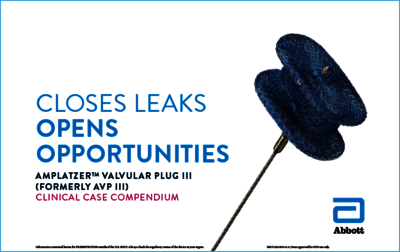VALVULAR PLUG III
STRUKTURELLE INTERVENTIONEN
Paravalvuläre Lecks (PVLs) sind weltweit ein häufiges
und schwieriges Problem.1 Der Amplatzer™ Valvular Plug III
wurde speziell entwickelt, um eine Vielzahl von Morphologien
zu verschließen und die Lebensqualität und Lebenserwartung
einer wachsenden Zahl von Patient:Innen zu verbessern.2-5
EINE LÖSUNG FÜR EIN ZENTRALES PROBLEM
Weltweit sind PVLs ein häufiges und schwieriges Problem, das bei 7 % bis 17 % der Mitralklappenersatzoperationen und 5 % bis 10 % der Aortenklappenersatzoperationen auftritt.1 Zu den Risikofaktoren für die Entwicklung von PVLs gehören: ringförmige Verkalkung, Brüchigkeit des Gewebes, frühere Endokarditis oder andere entzündliche Prozesse sowie der kürzliche Beginn einer Kortikosteroidtherapie.8 PVLs können kurz nach dem Klappenersatz oder mehrere Jahre später auftreten.2,6
Durch die Bereitstellung einer wirksamen Lösung für dieses zentrale Problem verbessert der Amplatzer™ Valvular Plug III die Lebensqualität einer wachsenden Zahl von Patienten.2-5
- Rama-Merchan J, Arribas-Jimenez A, et al. Prevalence and severity of paravalvular regurgitation in the Artificial Valve Endocarditis Reduction Trial (AVERT) echocardiography study. Rev Esp Cardiol. 2014;67:593-596.
- Ruiz CE, Hahn RT, Berrebi A, et al. Clinical trial principles and endpoint definitions for paravalvular leaks in surgical prosthesis: an expert statement. J Am Coll Cardiol. 2017;69(16):2067-2087. doi.org/10.1016/j.jacc.2017.02.038.
- Calvert PA, Northridge DB, Malik IS, et al. Percutaneous device closure of paravalvular leak: combined experience from the United Kingdom and Ireland. Circulation. 2016;134(13):934-944. doi.org/10.1161/CIRCULATIONAHA.116.022684.
- García E, Arzamendi D, Jimenez-Quevedo P, et al. Outcomes and predictors of success and complications for paravalvular leak closure: an analysis of the SpanisH real-wOrld paravalvular LEaks closure (HOLE) registry. EuroIntervention. 2017;12(16):1962-1968. https://doi.org/10.4244/EIJ-D-16-00581.
- Davidavicius G, Rucinskas K, Drasutiene A, et al. Hybrid approach for transcatheter paravalvular leak closure of mitral prosthesis in high-risk patients through transapical access. J Thorac Cardiovasc Surg. 2014;148(5):1965-1969. doi.org/10.1016/j.jtcvs.2014.05.001.
- Smolka G, Pysz P, Jasinski M, et al. Multiplug paravalvular leak closure using Amplatzer Vascular Plugs III: a prospective registry. Catheter Cardiovasc Interv. 2016;87(3):478-487. doi.org/10.1002/ccd.25992.
- Yildirim A, Goktekin O, Gorgulu S, et al. A new specific device in transcatheter prosthetic paravalvular leak closure: a prospective two-center trial. Catheter Cardiovasc Interv. 2016;88(4):618-624. doi.org/10.1002/ccd.26439.
- Angulo-Llanos R, Sarnago-Cebada F, Rivera AR, et al. Two-year follow up after surgical versus percutaneous paravalvular leak closure: a non-randomized analysis. Catheter Cardiovasc Interv. 2016;88(4):626-634. doi.org/10.1002/ccd.26459.
- Data on File at Abbott.
- Sánchez-Recalde A, Moreno R, Galeote G, et al. Immediate and midterm clinical course after percutaneous closure of paravalvular leakage. Rev Esp Cardiol (Engl Ed). 2014;67(8):615-623. doi.org/10.1016/j.rec.2014.01.031.


